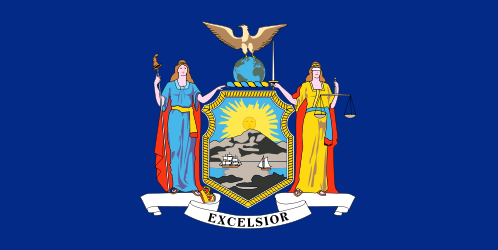United States
New York : Ever Upward

New York, a state in the Northeastern United States, is the 27th-most extensive, the fourth-most populous, and the seventh-most densely populated of the 50 United States. New York is bordered by New Jersey and Pennsylvania to the south and by Connecticut, Massachusetts, and Vermont to the east; it has a maritime border with Rhode Island off Long Island Sound to the south, as well as an international border with Ontario, Canada, to the northwest across Lake Champlain. The state of New York has a complex system of rivers, lakes, and canals.
The New York City Metropolitan Area is home to more than 23 million people, making it one of the most populous metropolitan areas in the world. New York City is the most populous city in the United States, with an estimated 8.4 million residents in 2016. Albany is New York’s state capital and the seat of Albany County.
New York : Ever Upward
Racism and Jim Crow laws were prevalent in New York state during the late 19th and early 20th centuries. NY was one of the Northern states that still had segregation laws on the books, although they were not always enforced. NY City was a destination for African Americans who migrated North in search of better opportunities, but they often faced discrimination and racism. In 1896, the Supreme Court case Plessy v. Ferguson upheld the constitutionality of “separate but equal” facilities for blacks and whites, which effectively legalized Jim Crow segregation throughout the United States.
New York state began to repeal its segregation laws in 1917, but it was not until 1964 that all of the state’s Jim Crow laws were finally eradicated. New York has a long history of racism, which has been perpetuated through institutional policies and individual attitudes. Despite progress in recent years, racism continues to be a problem in New York state.
Racism has been a persistent problem in NY City for centuries, and it continues to plague the city to this day. Despite being known as one of the most diverse cities in the world, New York still experiences incidents of racism that can range from microaggressions to violent hate crimes. In this article, we will explore the history of racism in New York, the current state of racism in the city, and the efforts being made to combat it.
Historically, New York has been a hotbed of racial tension. In the early days of the city, slavery was prevalent, with slaves comprising up to 20% of the population in the late 1700s. Even after slavery was abolished, racial segregation persisted, and African Americans were subject to discrimination in housing, employment, and education. In the mid-20th century, New York saw a surge in racial tensions with the rise of the civil rights movement and the emergence of groups like the Black Panthers. In the 1980s and 1990s, tensions were further exacerbated by police brutality and the crack epidemic, which disproportionately affected black and Latino communities.
Today, racism in New York can take many forms. While overt acts of racism like hate crimes still occur, the most common form of racism in the city is microaggressions. These are subtle acts of discrimination that can range from a white person clutching their purse when they see a black person walking by to a store owner following a Latino customer around their store. While these acts may seem minor, they can have a profound impact on the mental health and well-being of those who experience them.
In addition to microaggressions, structural racism also persists in areas like housing, education, and healthcare. For example, communities of color often have less access to quality healthcare and face higher rates of poverty and unemployment.
Despite the persistent problem of racism in New York, there are efforts being made to combat it. Organizations like the Anti-Defamation League and the NAACP work to educate the public about the harm caused by racism and to advocate for policies that promote equality and justice. There are also many grassroots organizations that work to empower communities of color and address issues like police brutality and unequal access to education and healthcare. In recent years, the Black Lives Matter movement has gained significant momentum in New York and across the country, drawing attention to the systemic racism and police brutality faced by black Americans.
In conclusion, racism continues to be a significant problem in New York City. While progress has been made since the days of slavery and segregation, there is still much work to be done to eradicate racism in all its forms
SUNDOWN TOWNS IN NEW YORK
Sundown town, in U.S. history, a town that excluded nonwhite people—most frequently African Americans—from remaining in town after sunset.
Here is a current list of sundown towns in New York. This list has been created by Tougaloo College in Tougaloo, MS. This list is a work in progress. Some cities have been confirmed as sundown towns and some are listed for other or similar reasons.
Amherst
Attica
Belle Terre
Bennington
Brighton
Bronxville
Buffalo *
Chazy
Cohoes *
Cold Spring
Cooperstown
Copiague
Cove Neck
Delmar
Elmont
Floral Park
Garden City
Glen Head
Glens Falls *
Green Island
Hamburg
Irondequoit
Johnsburg
Johnson City
Levittown
Mexico
Miller Place
New York *
North Amityville *
North Tonawanda
Nunda
Oceanside
Orchard Park
Pelham Manor
Penfield
Pleasantville
Rochester *
Roosevelt
Roscoe
Saratoga Springs
Sayville
Scarsdale
Sea Cliff
Seaford
Smithtown
Tonawanda
Tuxedo Park
Valley Stream
Voorheesville
West Elmira
Westchester County
Whitesboro
Yaphank
Yonkers












You must be logged in to post a comment Login